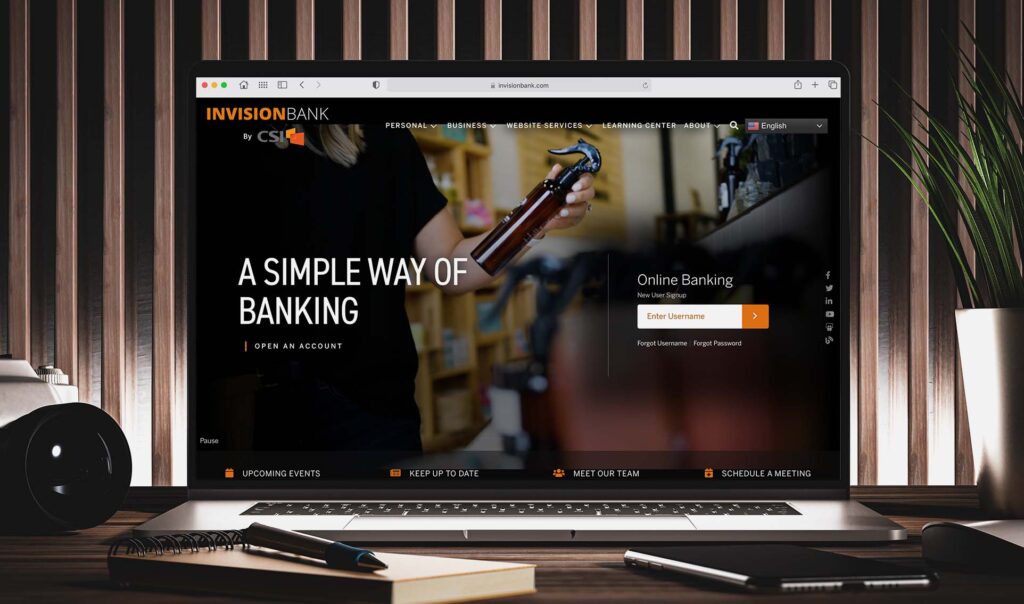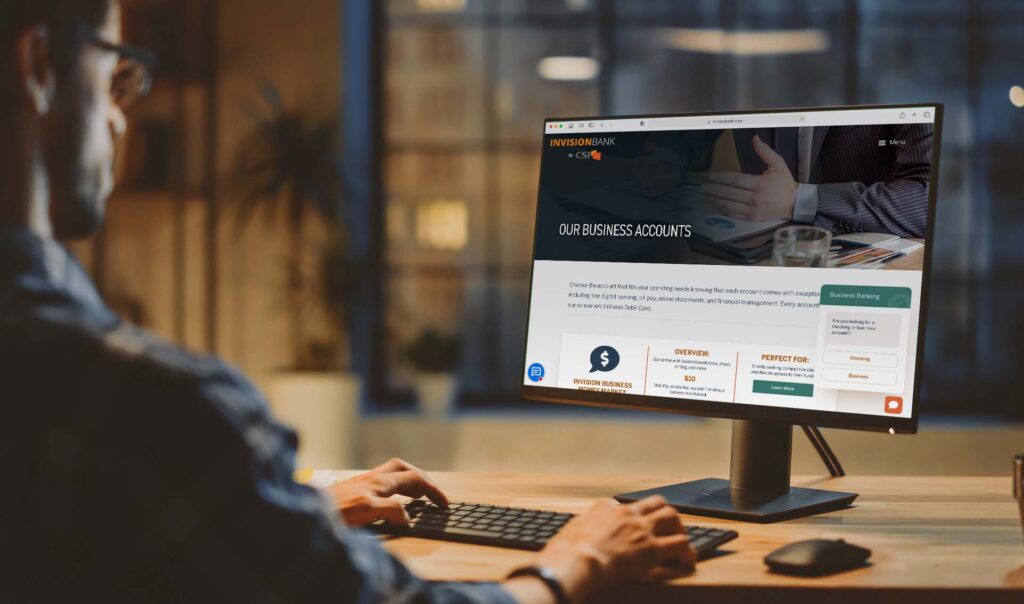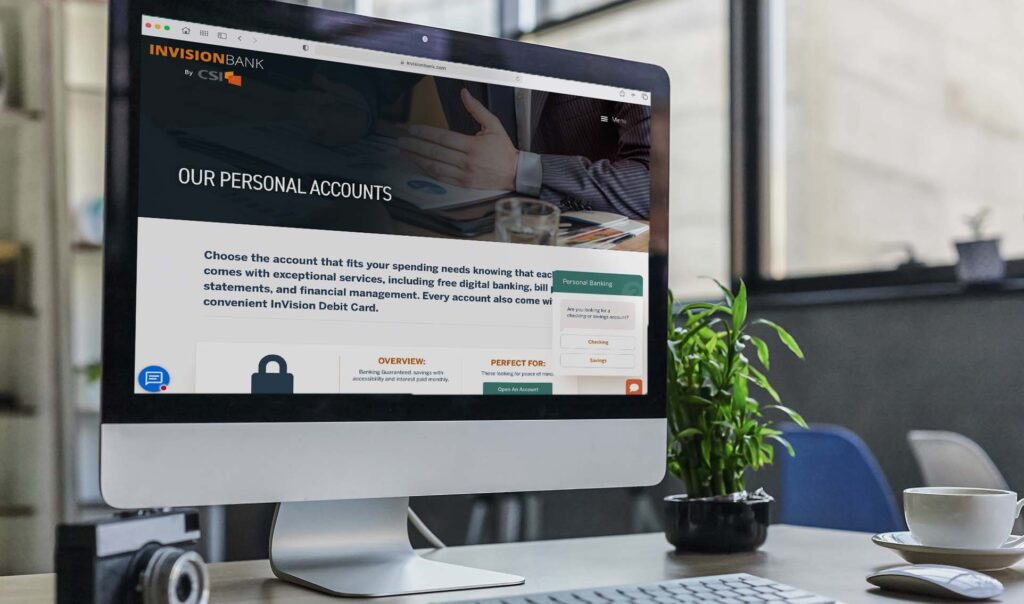As the face of your organization and often the first touchpoint, your website establishes your brand and preparedness for the future. An effective web presence instills confidence, provides customers or members with the financial information they need and keeps them engaged.
In a previous blog, we explored strategies for driving prospects to your website—including organic searches and social media—and some pointers for quality content. Now let’s dig into website design best practices you should implement to create a unique, captivating experience that maximizes engagement and eliminates compliance risk.
If you prefer a firsthand look at a solution to help you get there, check out this on-demand webinar.
1 – Visual Appeal
 It takes only seconds to form an impression about what it will be like to use your digital channels.
It takes only seconds to form an impression about what it will be like to use your digital channels.
With websites, visitors judge a book by its cover, including font, branding and color scheme. In fact, it takes only seconds to form an impression about what it will be like to use your digital channels.
If pictures are truly worth a thousand words, then those words should be directly pertinent to your organization and the services you offer. A landscaping company showing a picture of its office instead of the landscaping they have done is doing a better job selling their office than their work. The same premise holds true for financial institutions and other organizations.
In determining visuals, consider what would resonate and attract people in your community to do business with you. For instance, skyscrapers or coastal scenes can be stunning and eye-catching but probably would not be meaningful in an agricultural community.
- Pictures can be worth a thousand words, but to make them the right ones, portray relatable people and businesses. Movement on your website can also catch visitors’ eyes so long as you don’t go overboard.
- Videos done well are the perfect way to convey a great deal of information about who you are and what you do. As a bonus, they take up much less real estate on your website than text and make it more likely that visitors will consume your content.
Remember to keep visuals fresh and update them often. It may seem obvious, but images and videos are vital to the look and feel of your website. If you still have a winter holiday picture on your site in July, that image is now working against you.
2 – Ease of Use
If your institution’s website isn’t easy to use and navigate, it won’t matter how good it looks. There are some basics to consider that make it easily accessible for everyone, no matter how they interact:
- Search is a top priority and one where many organizations fall short. Your website’s search function must be straightforward and effective. Use suggested predictions when visitors begin typing and order the results by priority, such as your current marketing campaigns.
- Recommendations also make navigation and service faster. For instance, consider posting articles or links from one page to another relevant page. A virtual assistant with customized questions and “I want to” prompts elevate this service to the next level.
- Products should be prominent with straightforward descriptions and comparisons. Aim for a typical shopping experience by enabling an “add to cart” function and using familiar setups like product and feature lists. Your visitors are used to “filling their cart,” so allow them to do so with industry-specific offerings like savings accounts, fixed interest mortgages and financial planning.
Ultimately, your site should guide the more tech savvy visitors to self-service, but also facilitate easy decisions and the ability to receive help from your frontline staff as needed.
3 – Dynamic Content
Personalized content can go a long way to help consumers see themselves working with you. What kind of customer are they? Personal, business, investment or another category? In addition to content specified to these needs, consider:
- Location-specific content if you have different regions or branches in different locations
- Language-specific content or translations if you have a market area that predominantly speaks a language in addition to English
Remember what your visitors have selected but give them the choice to receive new targeted content. A customer may start with a business account, but if they have a good experience, it could lead to a personal or consumer relationship, too.
4 – Interaction
 It’s essential to deploy multiple methods for visitors to interact with you.
It’s essential to deploy multiple methods for visitors to interact with you.
Over the past few years, consumers have changed the way they do business. More and more research purchases online before spending and the number of purchases made purely online is similarly rising.
So, you must determine how you are going to stay connected with those visitors and keep them engaged. How does your customer base interact with your organization and who do they encounter?
It’s also essential that you deploy multiple methods for visitors to communicate with you:
- Online chat, including video chat and screen sharing, makes digital customer service far simpler and ultimately creates more satisfied customers or members that have confidence in your digital abilities
- Appointment scheduling maximizes your time and ensures visitors aren’t left waiting
- Contact information and pictures of branches allows visitors to contact you and know what to look for when they visit
- Location finders enable consumers to find the nearest locations no matter where they are, such as bank branches or ATMs
In addition, it’s important to provide content that encourages visitor interaction with your organization. For instance, providing front line staff bios helps consumers feel more comfortable working with those employees they’ll see most. Don’t forget to promote community involvement and what differentiates you from other financial institutions in your area.
5 – Integration
Now that you’ve got them, don’t let them go! The experience on your website should easily integrate with your digital experience. Keep visitors engaged with easy access to:
- Online account opening to turn initial engagement into the beginning of a new relationship within a single session
- Online applications for relevant applications like jobs or loans
- Online support to help with any questions and concerns or provide guidance to what they need
- Embedded videos and podcasts to establish your brand identity and build an understanding of your services and what sets you apart
- Social media activity embedded into the site, so visitors stay focused on you
6 – Mobile Focus
Over 80% of U.S. consumers access websites by phone, no matter the industry. Follow these best practices to make the best mobile experience possible:
- Place key information the top of the page to reduce scrolling and lower your bounce rate
- Deploy one-click buttons with simple calls to action like subscribe, register, open and apply
- Require minimal navigation by ensuring visitors do not have to click through too many pages
- Do not use pop ups, as they are distracting and can be frustrating
Ultimately, the only difference between mobile and online should be customer preference, and they’ll be searching for the organization that can meet theirs.
7 – Inclusivity
Lastly, make sure your website is accessible to everyone who visits. Crafting the perfect website is an ongoing process that must account for high customer expectations, specifically their accessibility standards. Make sure your website remains in adherence with ADA compliance guidelines by including:
- Color contrasts and appropriate font sizes to make it as readable as possible
- Text descriptions to provide more detail and assist those with visual impairments
- Audio descriptions to further convey images to the visually impaired
- Screen Reader compatibility to simply convey all the above
- Keyboard navigation capabilities for those who use your website without a mouse
Additionally, it may be advisable to provide other languages or translations to reach more visitors.
Getting the Most out of Your Website
 Is your institution making a lasting impression and giving consumers the right opportunities to engage?
Is your institution making a lasting impression and giving consumers the right opportunities to engage?
While incorporating website design best practices can be a daunting process, it is well worth it as first impressions last. Is your institution making a lasting impression and giving consumers the right opportunities to engage?
To see these attributes in practice, watch CSI’s on-demand webinar for our web design and hosting solution.
WATCH NOW